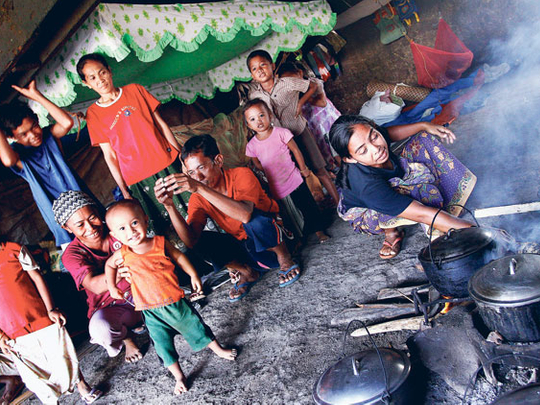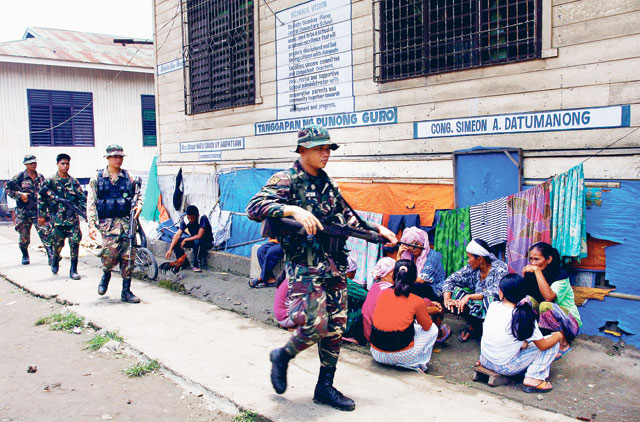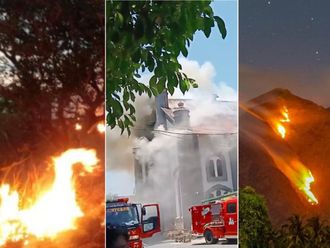
Camp Abu Bakr, Maguindanao: The journey from Cotabato City, via the Narciso Ramos Highway, which takes more than three hours to complete, had been relatively calm. The atmosphere was similar when I arrived at Camp Abu Bakr As Siddiqui, the former Moro Islamic Liberation Front's (MILF) base.
I had noticed that, since my visit in October 1999 to report on the start of peace talks between the government and MILF, the Camp Abu Bakr complex had undergone a number of changes. For example there were more paved roads than before.
Several hundred metres from where our vehicle had turned into the town of Matanog, a familiar Central Mindanao rural scene greets us: workers lugging pickaxes and spades as they set about work on a government irrigation project.
"The road works and the social services remind the people that there's a government in existence and that it is for them," the softly spoken Lieutenant Colonel Joven Gonzales, Deputy Commander of Camp Iranun told Gulf News.
Camp Iranun is located to the back of Camp Abu Bakr, a complex on 32,000 hectares of land, comprising the towns of Matanog, Parang, Buldon and Barira.
Camp Abu Bakr was once an area where the MILF virtually had complete freedom to roam, but now, a decade after government forces "liberated" it under the orders of the then President Joseph Estrada, the former main base of the Moro separatist group struggles to develop through the combined efforts of the local and national government, as well as the Armed Forces of the Philippines.
Checkpoint
While visiting Camp Abu Bakr, I asked the driver to stop by the roadside. Not far from the area where I once interviewed the late MILF Chieftain Selamat Hashim, I recalled where a former rebel checkpoint once stood, and where, now, a .30 calibre machine gun, held by a soldier, menacingly points at the road.
I remember seeing a canteen in the area, where both MILF soldiers and visitors alike could pick-up ‘pastil' (a local "grab-and-go"-type food of finely shredded chicken and rice, wrapped in a banana leaf) and leave as easily as they'd arrived.
I have a vivid recollection of this canteen because of its unusual payment custom which it calls the "honesty system".
"People can take as much pastil as they want with no one asking whether you've already paid for it," one Iranun store owner told me. It was assumed that anyone who took the food had paid for it or would pay for it later.
However, as we drove past the canteen, a bump in the road jolted me from my reminiscing all of a sudden and reminded me that this is July 2010 and not October 1999.
Positioned on strategically high ground, near the coast of the Celebes Sea, Camp Abu Bakr is a natural fortress. The MILF, and the Moro National Liberation Front (MILF) before them, held the stronghold for three decades, until the June 2000 government offensive.
However, decades of neglect and indifference from the central government in Manila turned Camp Abu Bakr into a hotbed of Moro separatism.
The rebel base was once the realm of some 15,000 MILF soldiers and their families, until Estrada launched "Operation Dominance" to retake the area. But now, several years on, the district has been transformed into a food production factory in Central Mindanao, with the help of the government and the private sector.
The government converted the camp into an economic zone, pumping in a 100-million peso (Dh8.1-million) development fund. It now boasts a wide variety of crops such as rice, vegetables, fruit, corn, coconut, coffee, marang, watermelons, banana, pumpkins, radish, string beans and tomatoes.
"I doubt if anyone will go hungry here any more. There's enough food for everyone to go around," Gonzales said.
People need not worry about their health either. State health workers now conduct regular visits to the thousands of residents in the four towns surrounding the complex.
Top official
My interview with Gonzales was cut short as I had to hurry back to Cotabato City for a session with a MILF top official with whom I had a prior arrangement.
It had dawned on me that I'd been covering the Mindanao conflict for nearly a decade and a half, both as a reporter and from the newsdesk; from the frontlines to the side lines; and all that time, the talks for peace had been punctuated by episodes of hostility.
I find it unusual that although, at different times, both sides have expressed their willingness to enter into dialogue, lasting peace remains elusive.
As Augusto Miclat, of the non-government Initiative for International Dialogue, pointed out, peace would not be easy unless a key ingredient was present. And that essential component he said was, "trust."
In hindsight, it occurred to me that talking about peace may not be at all much different from buying a pastil from the Camp Abu Bakr canteen.
All that is needed is good faith and trust so that all parties can go home without being left empty handed or short changed.
Factfile: The MILF
- The Moro Islamic Liberation Front (MILF) was formed sometime during the mid-1990s after Selamat Hashim led a break-away faction from the mainstream Moro National Liberation Front (MNLF).
- The MNLF, which unifying call is for the recognition of the Moros as a nation distinct from the Christianised Philippines, eventually signed a peace agreement with the government in 1996 under the leadership of Nur Misuari.
- MILF served as the united front organisation of Moro forces with the Bangsa Moro Army as its vanguard. It carried on with the struggle for the establishment of a Moro homeland and picked up from where the MNLF had left off. At the onset, the MILF espoused a more hardline approach in its campaign and implemented Shariah law in its areas. These are Maguindanao, Lanao, Basilan and North Cotabato.
- According to incumbent Chair Murad Ibrahim, the MILF currently has 120,000 men, but only 60 per cent of which are armed. Unlike other groups for fighting for national liberation that employed guerrilla warfare as its main form of armed struggle, the MILF waged largely conventional warfare and maintained permanent bases. It also intermittently employed bombing attacks using improvised explosive devices as a psychological-political, rather than a tactical weapon.
- The government, in a bid to check the growing strength of the MILF during early 2000, utilised militias such as the Civilian Volunteers Organisation (CVO) and the Citizens Armed Force Geographic Units (Cafgu). These same militia groups, under the command of local political families, are being accused of committing abuses and perpetuating the feudal relationships in certain Mindanao areas. Last November, militiamen under the command of Mayor Andal Ampatuan Jr. perpetrated massacre of 53 people in Maguindanao.
- The MILF is being besieged from threats within it. Familial ties and tribal loyalties figure prominently in the political-economic realities in MILF areas. During the period when the MILF was at the peak of its strength, conflict was settled at the inter-family or clan level trough local peace pacts. Recently however, there had been increasing signs that this hold by the MILF on its forces are waning as there are increasing incidences of "rido" or bloody clan conflict.
- With the death of hardline ideologue Selamat Hashim in 2003--and with the loss of strategic MILF camps such as Camp Abubakre, the group has taken a more flexible approach concerning peace negotiations in particular and Mindanao and the Moro question in general. It has said several times that it is open to talking peace with the government of President Benigno Aquino III.













